Low-Profile Antenna System for Cognitive Radio in IoST CubeSat Applications
Abstract
:1. Introduction
2. Antenna System Structure
2.1. Wideband Antenna
2.2. Narrowband Reconfigurable Antenna
3. Antenna Fabrication and Discussion of Results
3.1. Scattering Parameters
3.2. Radiation Characteristics
- Anechoic chamber: The chamber is large enough to accommodate the antenna under test and other required testing equipment. The walls, ceiling, and floor of the chamber are covered with radiation-absorbing material to prevent reflections and create an environment free of external interference.
- Antenna positioning system: The antenna positioning system is used to precisely control the position and orientation of the antenna under test. This system typically includes a rotation stage and one or more translation stages, which allow the antenna to be positioned at various distances and angles from the measurement equipment.
- Signal generator: The signal generator is used to generate the RF signal that excites the antenna under test. The frequency and power level of the signal can be adjusted as needed.
- RF receiver: The RF receiver is used to measure the signal received by the antenna under test. The receiver is typically connected to an antenna or probe that is positioned at a fixed distance and angle from the antenna under test.
- Data acquisition system: The data acquisition system is used to collect and store the measurement data. This system includes a computer, software, and any necessary interfaces for controlling the measurement equipment and recording the data.
- Calibration equipment: The calibration equipment is used to calibrate the measurement system and ensure accurate results.
3.3. MIMO Diversity (ECC)
3.4. Comparison
4. Conclusions
Author Contributions
Funding
Institutional Review Board Statement
Informed Consent Statement
Data Availability Statement
Acknowledgments
Conflicts of Interest
References
- Saeed, N.; Elzanaty, A.; Almorad, H.; Dahrouj, H.; Al-Naffouri, T.Y.; Alouini, M.S. CubeSat Communications: Recent Advances and Future Challenges. IEEE Commun. Surv. Tutor. 2020, 22, 1839–1862. [Google Scholar] [CrossRef]
- Lepcha, P.; Malmadayalage, T.D.; Örger, N.C.; Purio, M.A.; Duran, F.; Kishimoto, M.; El-Megharbel, H.A.; Cho, M. Assessing the Capacity and Coverage of Satellite IoT for Developing Countries Using a CubeSat. Appl. Sci. 2022, 12, 8623. [Google Scholar] [CrossRef]
- Fernandez, L.; Sobrino, M.; Ruiz-De-Azua, J.A.; Calveras, A.; Camps, A. Design of a Deployable Helix Antenna at L-Band for a 1-Unit CubeSat: From Theoretical Analysis to Flight Model Results. Sensors 2022, 22, 3633. [Google Scholar] [CrossRef] [PubMed]
- Akyildiz, I.F.; Kak, A. The Internet of Space Things/CubeSats. IEEE Netw. 2019, 33, 212–218. [Google Scholar] [CrossRef]
- Nieto-Chaupis, H. Hyper Secure Cognitive Radio Communications in an Internet of Space Things Network Based on the BB84 Protocol. In Proceedings of the 2020 Intermountain Engineering, Technology and Computing (IETC), Orem, UT, USA, 2–3 October 2020; pp. 1–5. [Google Scholar] [CrossRef]
- Ramahatla, K.; Mosalaosi, M.; Yahya, A.; Basutli, B. Multiband Reconfigurable Antennas for 5G Wireless and CubeSat Applications: A Review. IEEE Access 2022, 10, 40910–40931. [Google Scholar] [CrossRef]
- Almalki, F.A.; Ben Othman, S. Predicting Joint Effects on CubeSats to Enhance Internet of Things in GCC Region Using Artificial Neural Network. Mob. Inf. Syst. 2021, 2021, 1827155. [Google Scholar] [CrossRef]
- Hussain, R.; Ikram, M.; Algarni, A.M.; Iqbal, S.S. Dual Sense Circularly Polarized Compact Slot Antenna for CubeSat Applications. IEEE Access 2022, 10, 111732–111737. [Google Scholar] [CrossRef]
- Xu, C.; Yang, T.; Song, H. Spectrum Sensing of Cognitive Radio for CubeSat Swarm Network. In Proceedings of the 2021 IEEE/AIAA 40th Digital Avionics Systems Conference (DASC), San Antonio, TX, USA, 3–7 October 2021; pp. 1–8. [Google Scholar] [CrossRef]
- Ortigueira, R.; Fraire, J.A.; Becerra, A.; Ferrer, T.; Cespedes, S. RESS-IoT: A Scalable Energy-Efficient MAC Protocol for Direct-to-Satellite IoT. IEEE Access 2021, 9, 164440–164453. [Google Scholar] [CrossRef]
- Sultan, K.; Abdullah, H.; Abdallah, E.; El-Hennawy, H. MOM/GA-Based Virtual Array for Radar Systems. Sensors 2020, 20, 713. [Google Scholar] [CrossRef]
- Zhang, W.; Behbahani, A.S.; Eltawil, A.M. Cognitive Route Selection and Frequency Allocation for CubeSat Swarm. In Proceedings of the 2021 IEEE Cognitive Communications for Aerospace Applications Workshop (CCAAW), Cleveland, OH, USA, 21–23 June 2021; pp. 1–5. [Google Scholar] [CrossRef]
- Bilen, S.; Mortensen, D.; Reinhart, R.; Wyglinski, A. Where no radio has gone before: Cognitive radios can keep deep-space missions connected to earth even when faced with Alien environments. IEEE Spectr. 2020, 57, 44–50. [Google Scholar] [CrossRef]
- Devaraj, K.; Ligon, M.; Blossom, E.; Breu, J.; Klofas, B.; Colton, K.; Kingsbury, R. Planet High Speed Radio: Crossing Gbps from a 3U Cubesat. In Proceedings of the 33rd Annual AIAA/USU Conference on Small Satellites, Logan, UT, USA, 3–8 August 2019. [Google Scholar]
- Zaman, I.U.; Behbahani, A.; Bayer, M.; Shaboyan, S.; Eltawil, A.; Boyraz, O. A Comparative Study of Inter Cubesat High Speed Links: Rf, Mmwave and Optical; Technical Report No. 00014; University of California Irvine: Irvine, CA, USA, 2019. [Google Scholar]
- Ikram, M.; Sultan, K.; Lateef, M.F.; Alqadami, A.S.M. A Road towards 6G Communication—A Review of 5G Antennas, Arrays, and Wearable Devices. Electronics 2022, 11, 169. [Google Scholar] [CrossRef]
- Blumenschein, L.H.; Gan, L.T.; Fan, J.A.; Okamura, A.M.; Hawkes, E.W. A Tip-Extending Soft Robot Enables Reconfigurable and Deployable Antennas. IEEE Robot. Autom. Lett. 2018, 3, 949–956. [Google Scholar] [CrossRef]
- Costantine, J.; Tawk, Y.; Christodoulou, C.G.; Banik, J.; Lane, S. CubeSat Deployable Antenna Using Bistable Composite Tape-Springs. IEEE Antennas Wirel. Propag. Lett. 2012, 11, 285–288. [Google Scholar] [CrossRef]
- Costantine, J.; Tawk, Y.; Maqueda, I.; Sakovsky, M.; Olson, G.; Pellegrino, S.; Christodoulou, C.G. UHF Deployable Helical Antennas for CubeSats. IEEE Trans. Antennas Propag. 2016, 64, 3752–3759. [Google Scholar] [CrossRef]
- Decrossas, E.; Chahat, N.; Walkemeyer, P.E.; Velasco, B.S. Deployable Circularly Polarized UHF Printed Loop Antenna for Mars Cube One (MarCO) CubeSat. In Proceedings of the 2019 IEEE International Symposium on Antennas and Propagation and USNC-URSI Radio Science Meeting, Atlanta, GA, USA, 7–12 July 2019; pp. 1719–1720. [Google Scholar] [CrossRef]
- Hayes, G.J.; Liu, Y.; Genzer, J.; Lazzi, G.; Dickey, M.D. Self-Folding Origami Microstrip Antennas. IEEE Trans. Antennas Propag. 2014, 62, 5416–5419. [Google Scholar] [CrossRef]
- Johnson, A.D.; Caripidis, J.A.; Venkatakrishnan, S.B.; Ali, M.; Volakis, J.L. Deployable Inverted-Hat Monopole with 3:1 Constant Gain Bandwidth. IEEE Antennas Wirel. Propag. Lett. 2020, 19, 935–938. [Google Scholar] [CrossRef]
- Liu, X.; Zekios, C.L.; Georgakopoulos, S.V. Analysis of a Packable and Tunable Origami Multi-Radii Helical Antenna. IEEE Access 2019, 7, 13003–13014. [Google Scholar] [CrossRef]
- Lakrit, S.; Nella, A.; Das, S.; Madhav, B.T.P.; Murali Krishna, C. An integrated three-antenna structure for 5G, WLAN, LTE and ITU band cognitive radio communication. AEU—Int. J. Electron. Commun. 2021, 139, 153906. [Google Scholar] [CrossRef]
- Nguyen, T.K.; Bui, C.D.; Narbudowicz, A.; Nguyen-Trong, N. Frequency-Reconfigurable Antenna with Wide- and Narrow-band Modes for sub-6 GHz Cognitive Radio. IEEE Antennas Wirel. Propag. Lett. 2022, 22, 64–68. [Google Scholar] [CrossRef]
- Alam, T.; Thummaluru, S.R.; Chaudhary, R.K. Integration of MIMO and Cognitive Radio for Sub-6 GHz 5G Applications. IEEE Antennas Wirel. Propag. Lett. 2019, 18, 2021–2025. [Google Scholar] [CrossRef]
- Nella, A.; Gandhi, A.S. A Five-Port Integrated UWB and Narrowband Antennas System Design for CR Applications. IEEE Trans. Antennas Propag. 2018, 66, 1669–1676. [Google Scholar] [CrossRef]
- Hussain, R.; Sharawi, M.S.; Shamim, A. An Integrated Four-Element Slot-Based MIMO and a UWB Sensing Antenna System for CR Platforms. IEEE Trans. Antennas Propag. 2018, 66, 978–983. [Google Scholar] [CrossRef]
- Chacko, B.P.; Augustin, G.; Denidni, T.A. Electronically Reconfigurable Uniplanar Antenna with Polarization Diversity for Cognitive Radio Applications. IEEE Antennas Wirel. Propag. Lett. 2015, 14, 213–216. [Google Scholar] [CrossRef]
- Yongfeng, W.; Naizhi, W.; Denidni, T.A.; Qingsheng, Z.; Gao, W. Integrated Ultrawideband/Narrowband Rectangular Dielectric Resonator Antenna for Cognitive Radio. IEEE Antennas Wirel. Propag. Lett. 2014, 13, 694–697. [Google Scholar] [CrossRef]
- Pazin, L.; Leviatan, Y. Reconfigurable Rotated-T Slot Antenna for Cognitive Radio Systems. IEEE Trans. Antennas Propag. 2014, 62, 2382–2387. [Google Scholar] [CrossRef]
- Wu, T.; Li, R.L.; Eom, S.Y.; Myoung, S.S.; Lim, K.; Laskar, J.; Jeon, S.I.; Tentzeris, M.M. Switchable Quad-Band Antennas for Cognitive Radio Base Station Applications. IEEE Trans. Antennas Propag. 2010, 58, 1468–1476. [Google Scholar] [CrossRef]
- Islam, H.; Das, S.; Ali, T.; Bose, T.; Prakash, O.; Kumar, P. A Frequency Reconfigurable MIMO Antenna with Bandstop Filter Decoupling Network for Cognitive Communication. Sensors 2022, 22, 6937. [Google Scholar] [CrossRef] [PubMed]
- Abulgasem, S.; Tubbal, F.; Raad, R.; Theoharis, P.I.; Lu, S.; Iranmanesh, S. Antenna Designs for CubeSats: A Review. IEEE Access 2021, 9, 45289–45324. [Google Scholar] [CrossRef]
- Hussain, R.; Aljaloud, K.; Rao, A.S.; Algarni, A.M.; Alqahtani, A.H.; Aziz, A.; Aladadi, Y.T.; Alhuwaimel, S.I.; Hussain, N. Miniaturized Folded-Slot CubeSat MIMO Antenna Design with Pattern Diversity. Sensors 2022, 22, 7855. [Google Scholar] [CrossRef]
- Ernest, A.J.; Tawk, Y.; Costantine, J.; Christodoulou, C.G. A Bottom Fed Deployable Conical Log Spiral Antenna Design for CubeSat. IEEE Trans. Antennas Propag. 2015, 63, 41–47. [Google Scholar] [CrossRef]
- Tawk, Y. Physically Controlled CubeSat Antennas with an Adaptive Frequency Operation. IEEE Antennas Wirel. Propag. Lett. 2019, 18, 1892–1896. [Google Scholar] [CrossRef]
- Chen, C. A Dual-Band Circularly Polarized Shared-Aperture Antenna for 1U CubeSat Applications. IEEE Trans. Antennas Propag. 2022, 70, 3818–3823. [Google Scholar] [CrossRef]
- Veljovic, M.J.; Skrivervik, A.K. Aperture-Coupled Low-Profile Wideband Patch Antennas for CubeSat. IEEE Trans. Antennas Propag. 2019, 67, 3439–3444. [Google Scholar] [CrossRef]
- Leszkowska, L.; Rzymowski, M.; Nyka, K.; Kulas, L. High-Gain Compact Circularly Polarized X-Band Superstrate Antenna for CubeSat Applications. IEEE Antennas Wirel. Propag. Lett. 2021, 20, 2090–2094. [Google Scholar] [CrossRef]
- Wang, J.; Manohar, V.; Rahmat-Samii, Y. Enabling the Internet of Things with CubeSats: A review of representative beamsteerable antenna concepts. IEEE Antennas Propag. Mag. 2021, 63, 14–28. [Google Scholar] [CrossRef]
- An, W.; Xiong, L.; Xu, S.; Yang, F.; Fu, H.P.; Ma, J.G. A Ka-Band High-Efficiency Transparent Reflectarray Antenna Integrated with Solar Cells. IEEE Access 2018, 6, 60843–60851. [Google Scholar] [CrossRef]
- Zarbakhsh, S.; Akbari, M.; Farahani, M.; Ghayekhloo, A.; Denidni, T.A.; Sebak, A.R. Optically Transparent Subarray Antenna Based on Solar Panel for CubeSat Application. IEEE Trans. Antennas Propag. 2020, 68, 319–328. [Google Scholar] [CrossRef]
- Hwang, M.; Kim, G.; Kim, S.; Jeong, N.S. Origami-Inspired Radiation Pattern and Shape Reconfigurable Dipole Array Antenna at C-Band for CubeSat Applications. IEEE Trans. Antennas Propag. 2021, 69, 2697–2705. [Google Scholar] [CrossRef]
- Liu, S.; Raad, R.; Theoharis, P.I.; Tubbal, F. Dual-Band Folded-End Dipole Antenna for Plastic CubeSats. IEEE J. Miniat. Air Space Syst. 2020, 1, 172–178. [Google Scholar] [CrossRef]
- Kothapudi, V.K.; Kumar, V. A single layer S/X-band series-fed shared aperture antenna for SAR applications. Prog. Electromagn. Res. C 2017, 76, 207–219. [Google Scholar] [CrossRef]
- Yao, Y.; Liao, S.; Wang, J.; Xue, K.; Balfour, E.A.; Luo, Y. A New Patch Antenna Designed for CubeSat: Dual feed, L\/S dual-band stacked, and circularly polarized. IEEE Antennas Propag. Mag. 2016, 58, 16–21. [Google Scholar] [CrossRef]
- Meirambekuly, N.; Karibayev, B.A.; Namazbayev, T.A.; Ibrayev, G.-G.A.E.; Orynbassar, S.O.; Ivanovich, S.A.; Temirbayev, A.A. A High Gain Deployable L/S Band Conical Helix Antenna Integrated with Optical System for Earth Observation CubeSats. IEEE Access 2023, 11, 23097–23106. [Google Scholar] [CrossRef]
- Tariq, S.; Baktur, R. Circularly polarized UHF up- and downlink antennas integrated with CubeSat solar panels. In Proceedings of the 2015 IEEE International Symposium on Antennas and Propagation & USNC/URSI National Radio Science Meeting, Vancouver, BC, Canada, 19–24 July 2015; pp. 1424–1425. [Google Scholar] [CrossRef]
- Johnson, A.D.; Manohar, V.; Venkatakrishnan, S.B.; Volakis, J.L. Low-Cost S-Band Reconfigurable Monopole/Patch Antenna for CubeSats. IEEE Open J. Antennas Propag. 2020, 1, 598–603. [Google Scholar] [CrossRef]

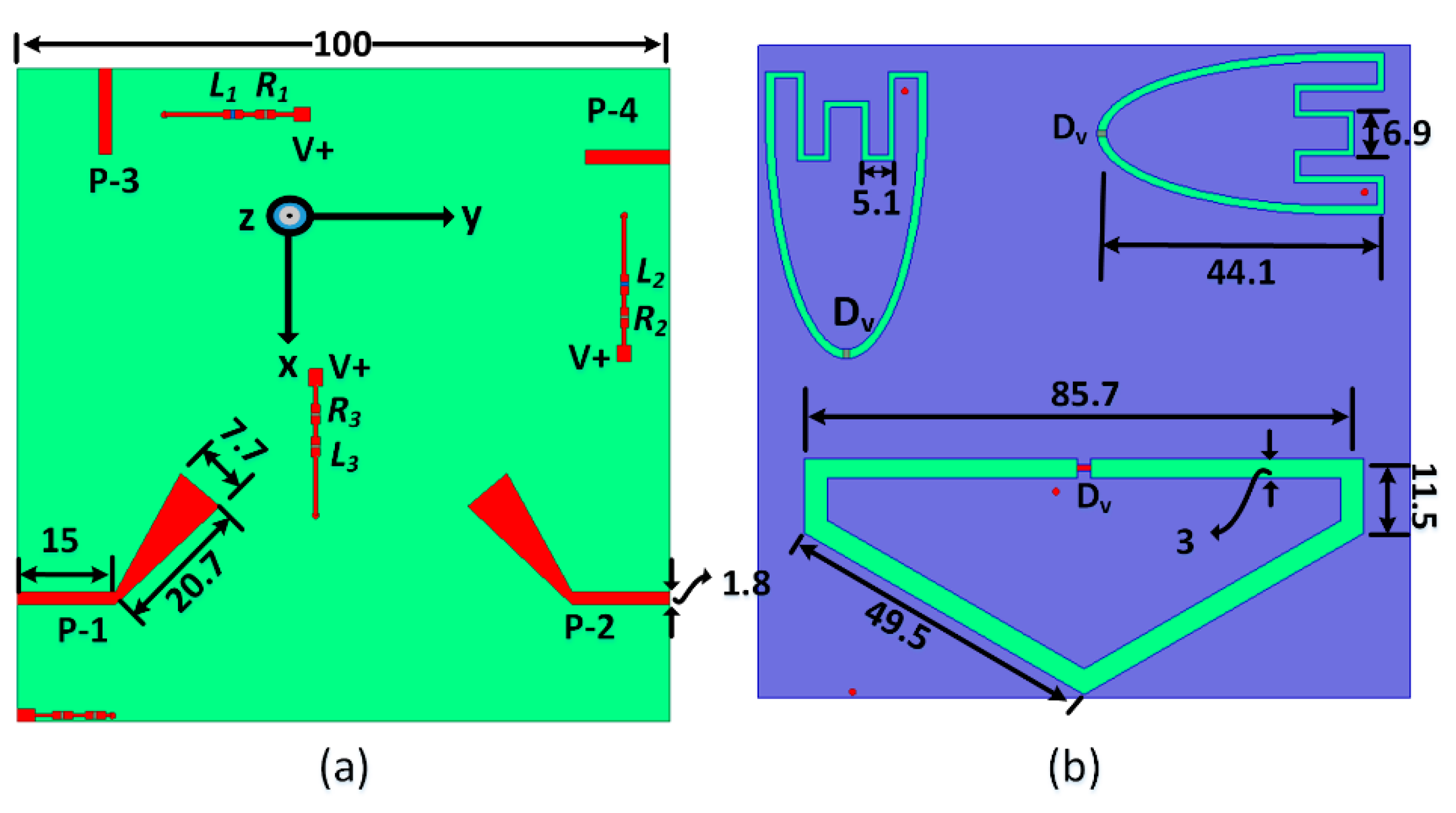
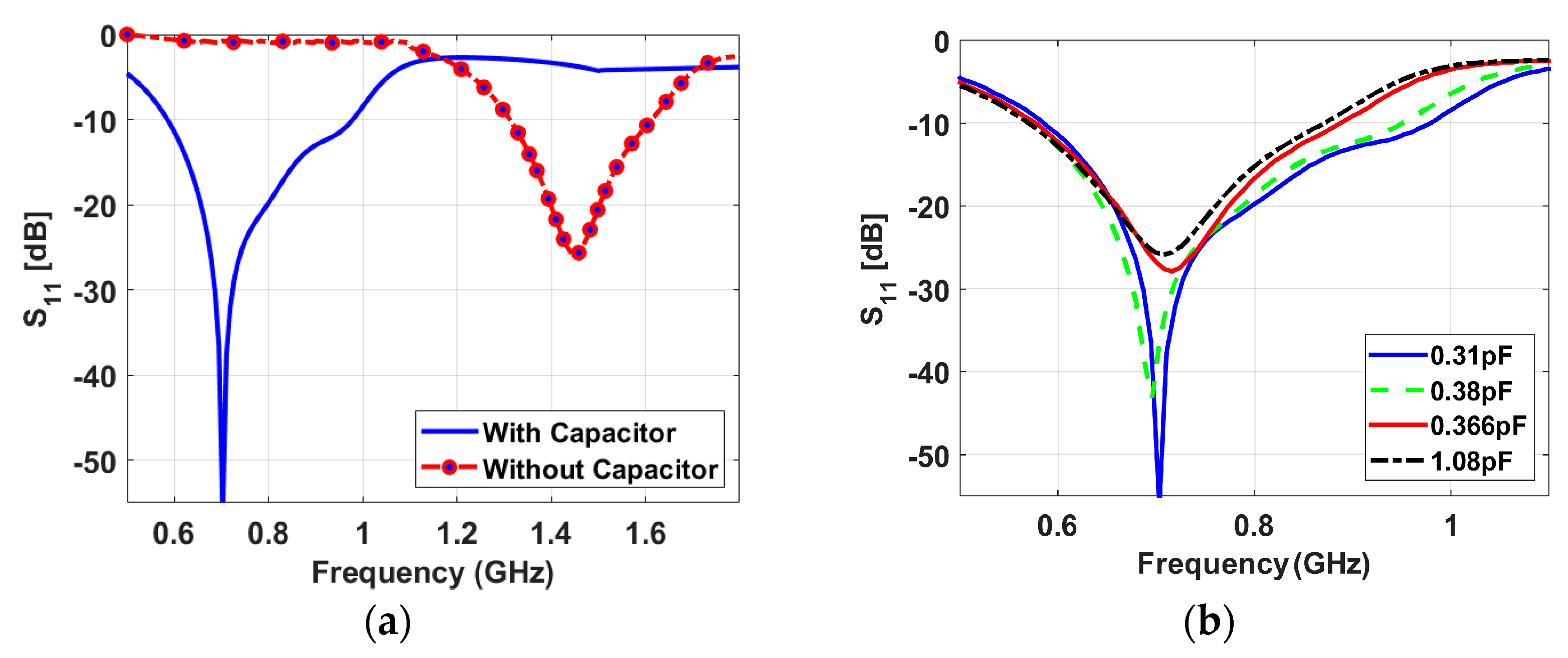


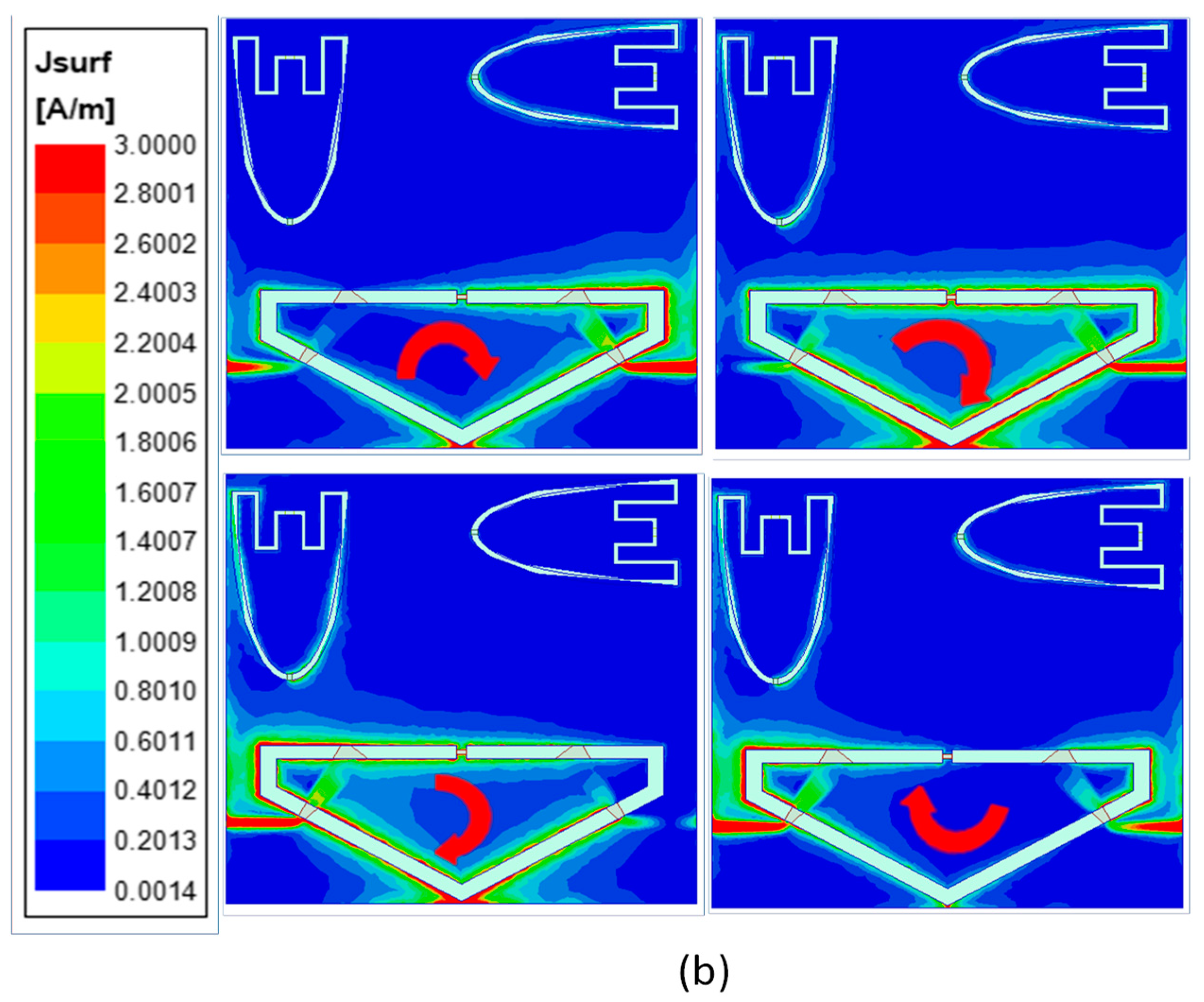
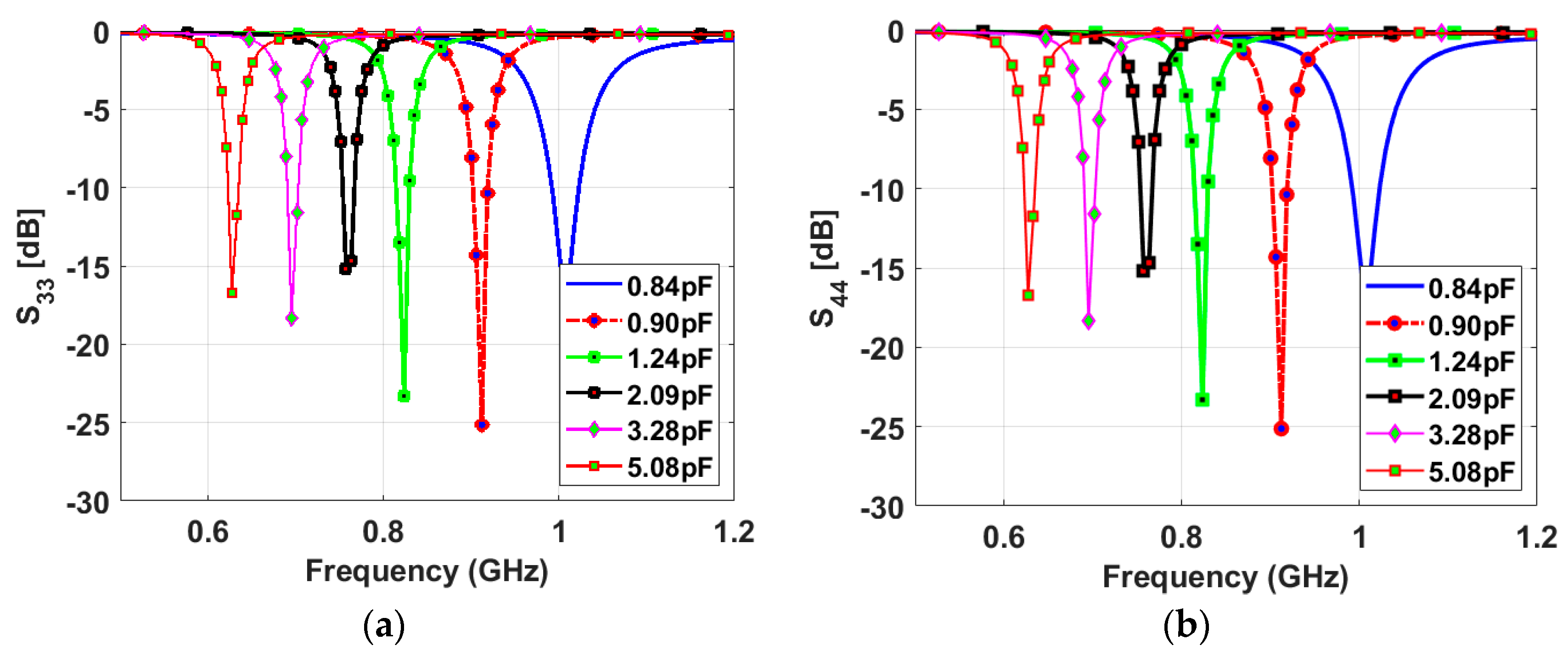
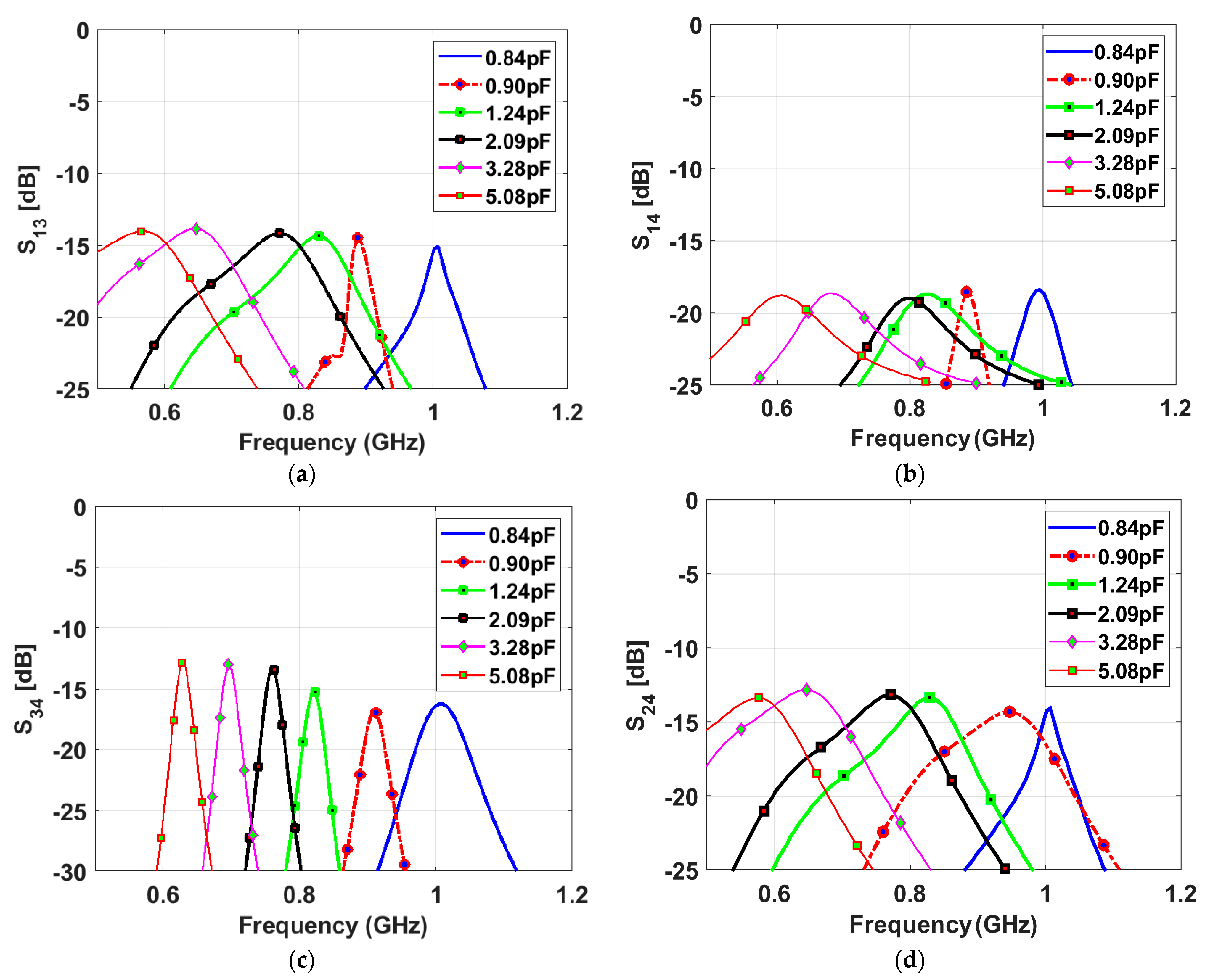
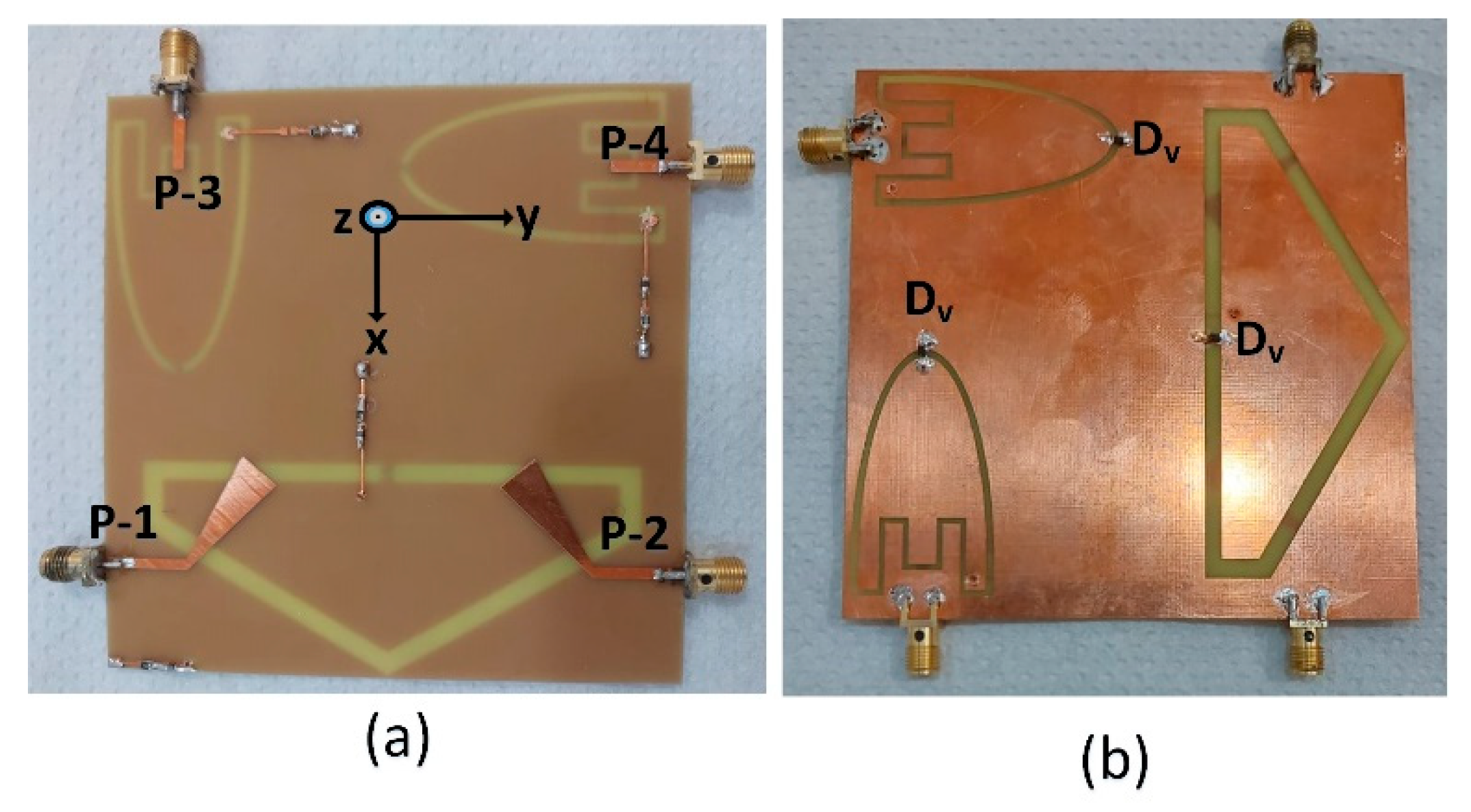
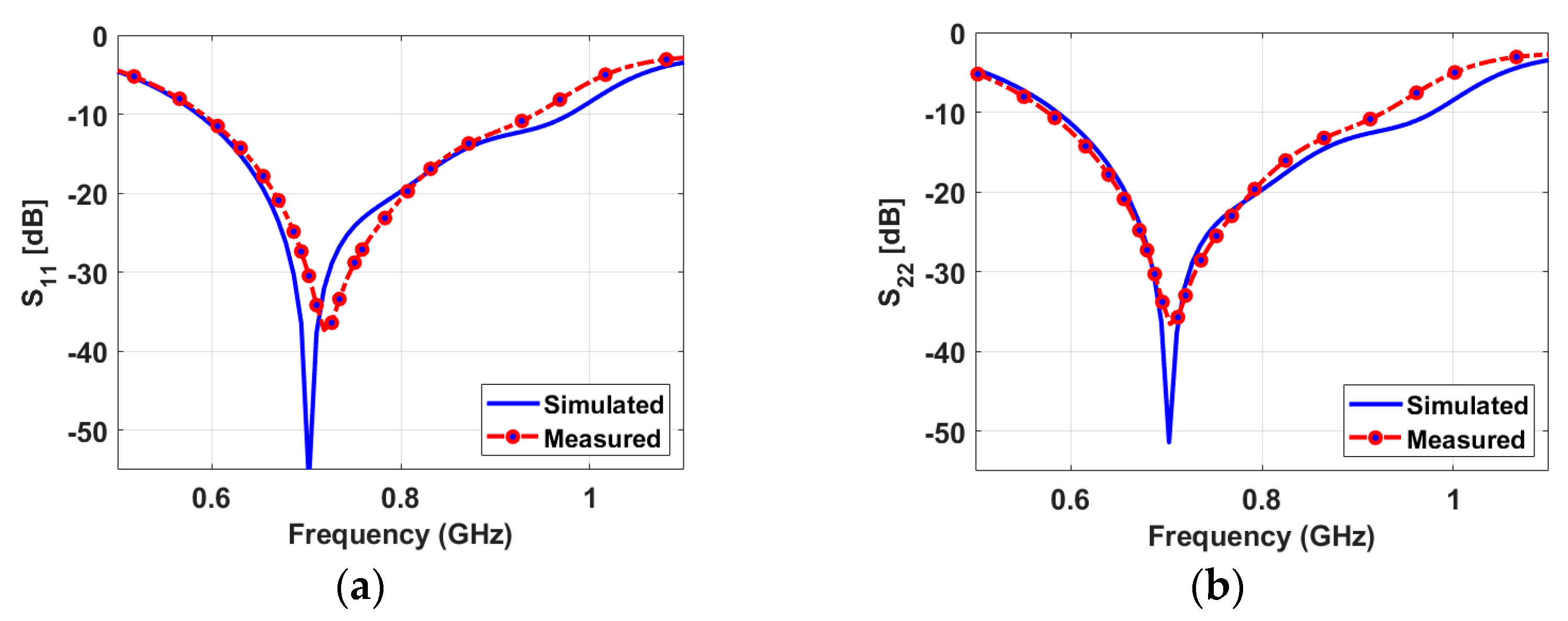
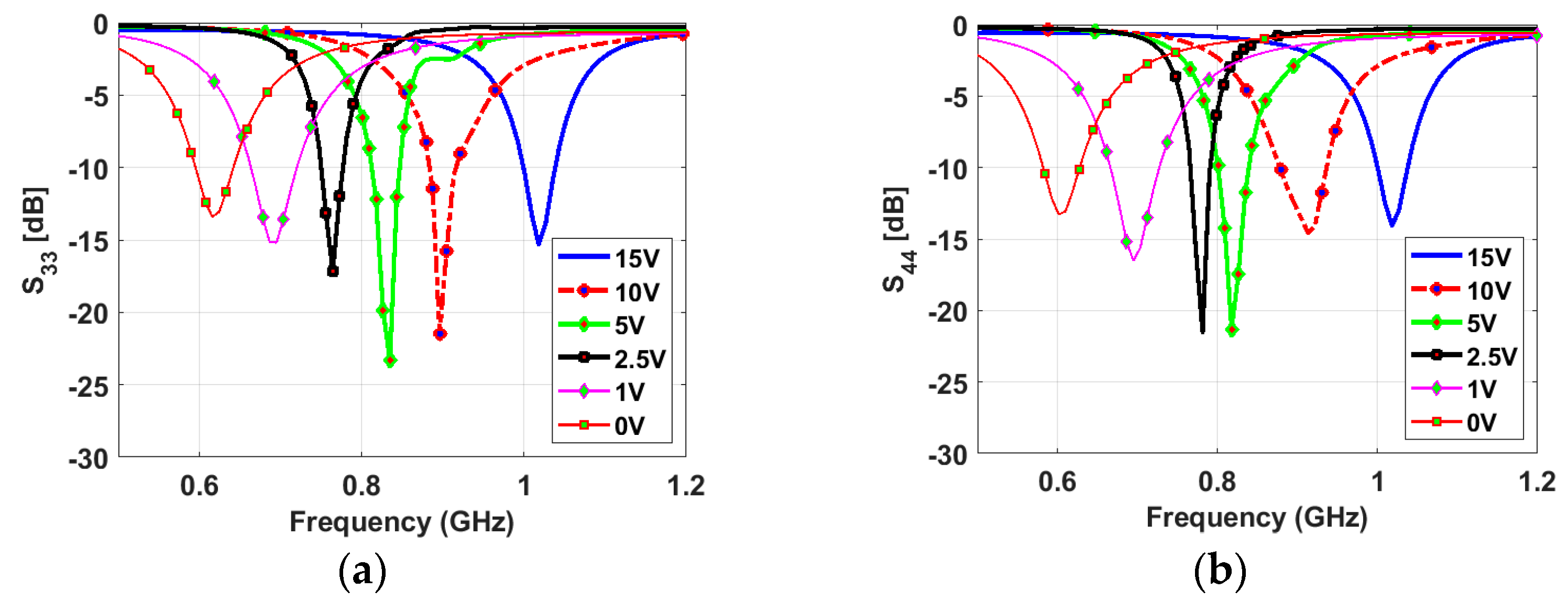
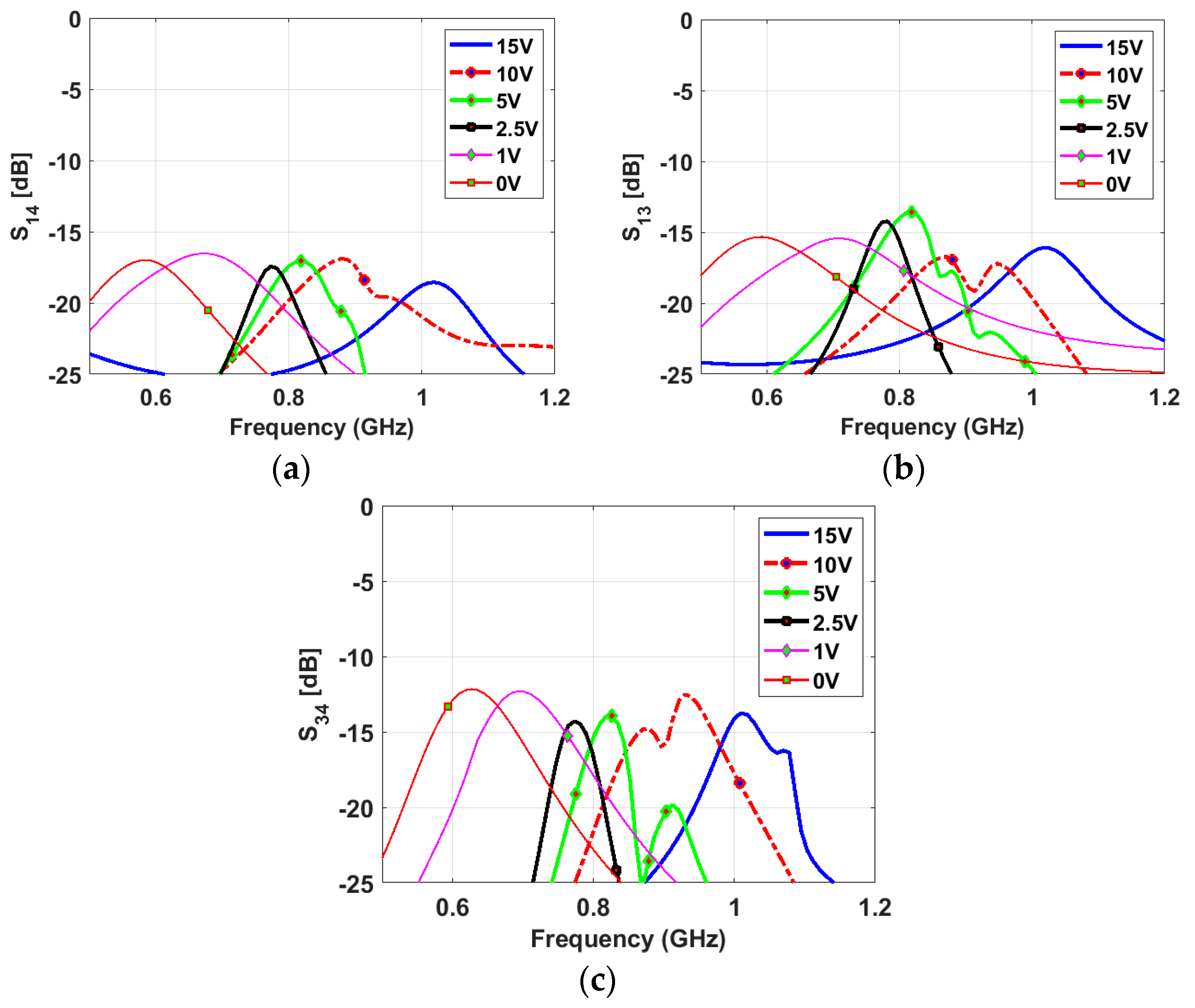
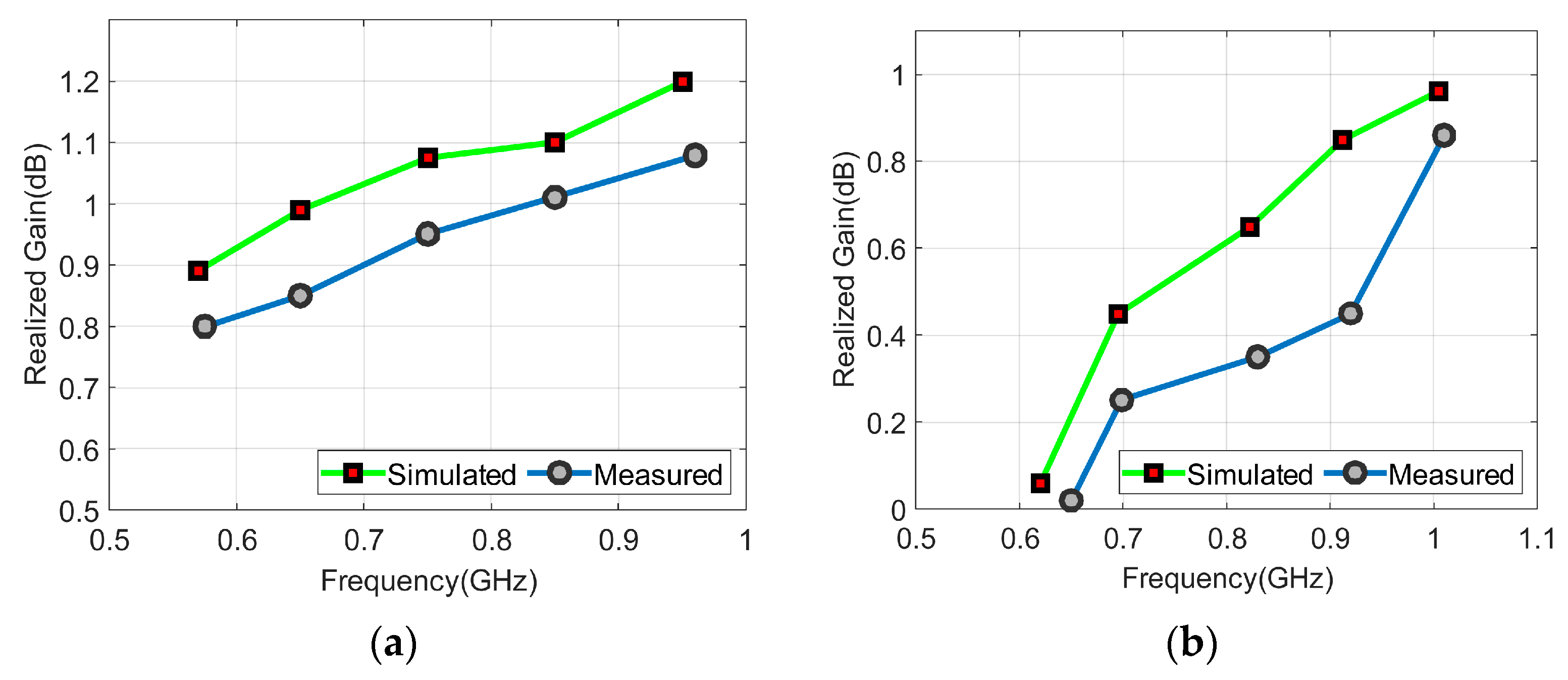
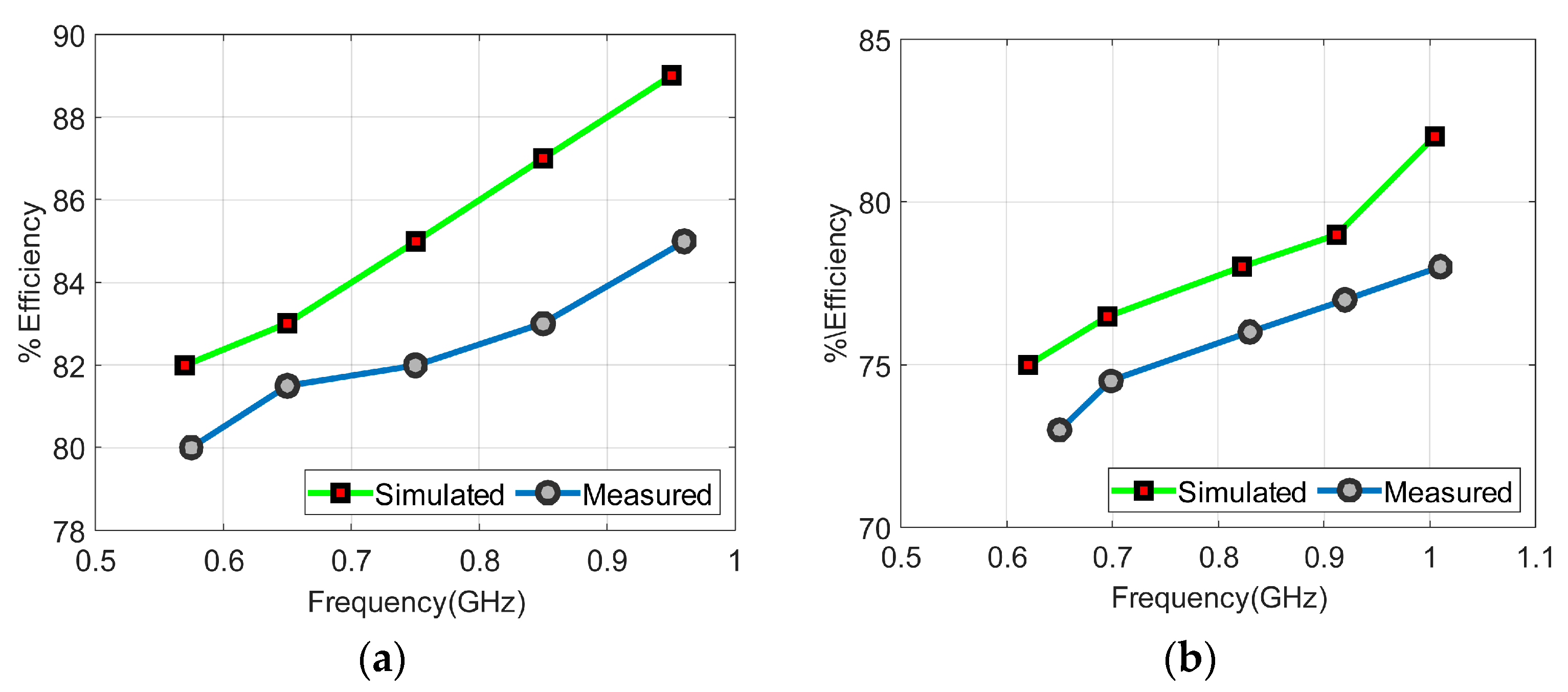
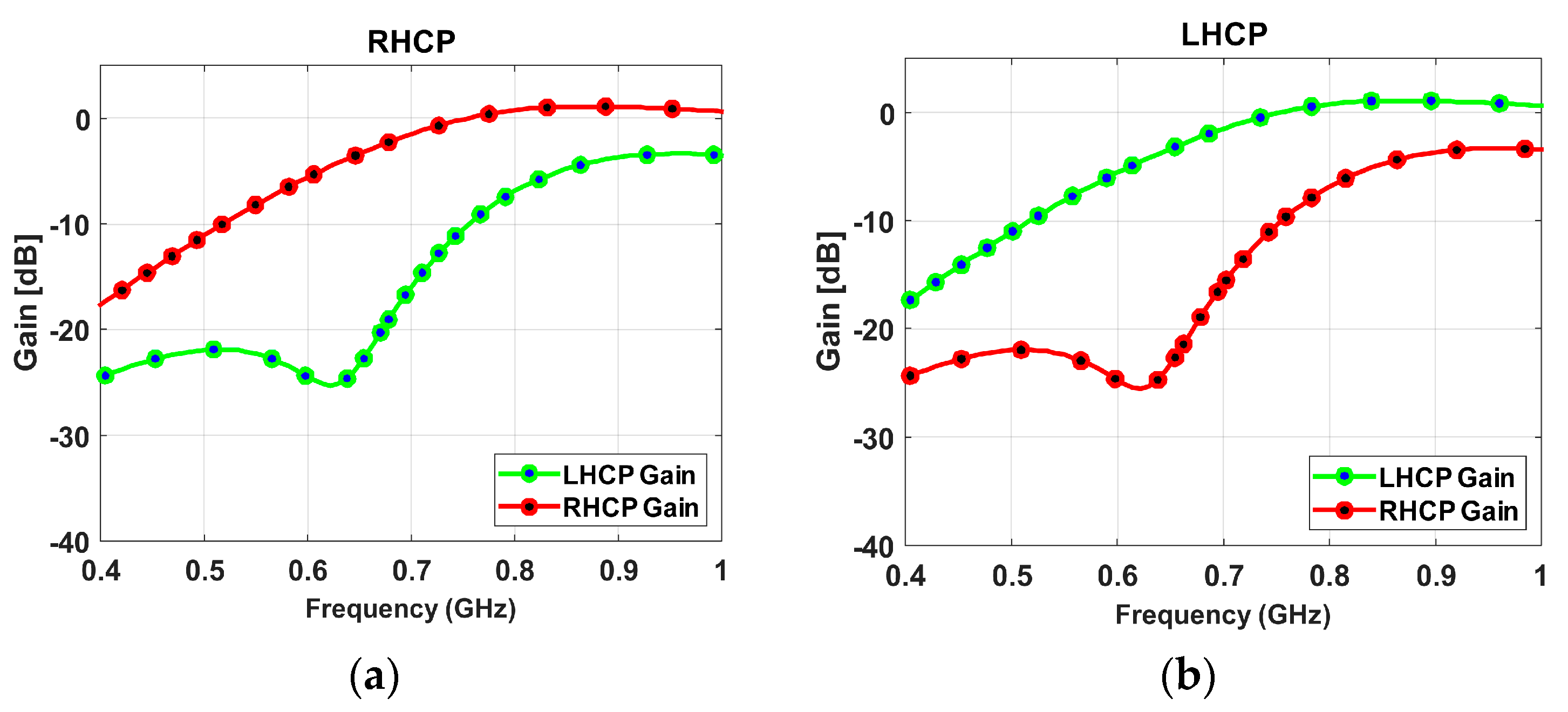
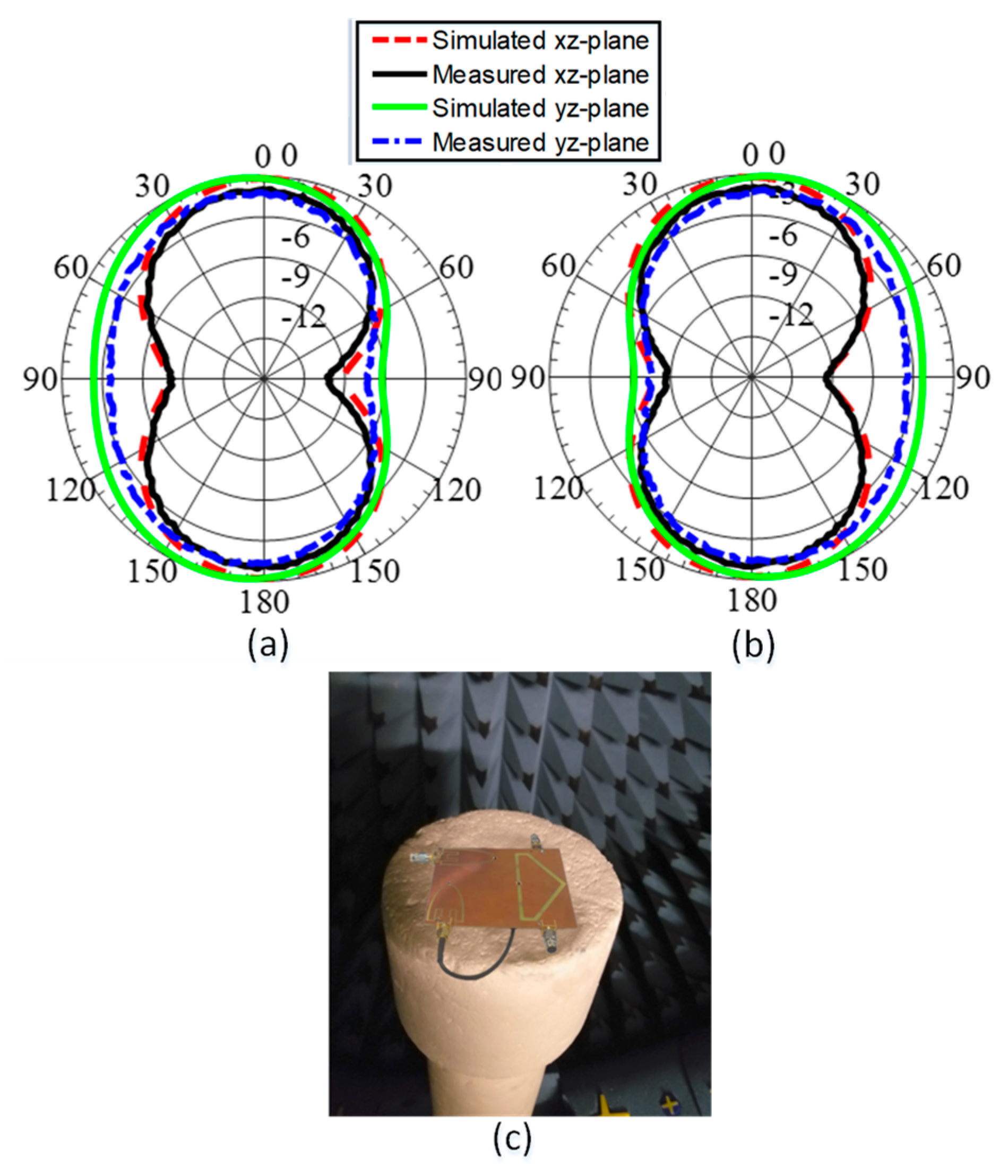
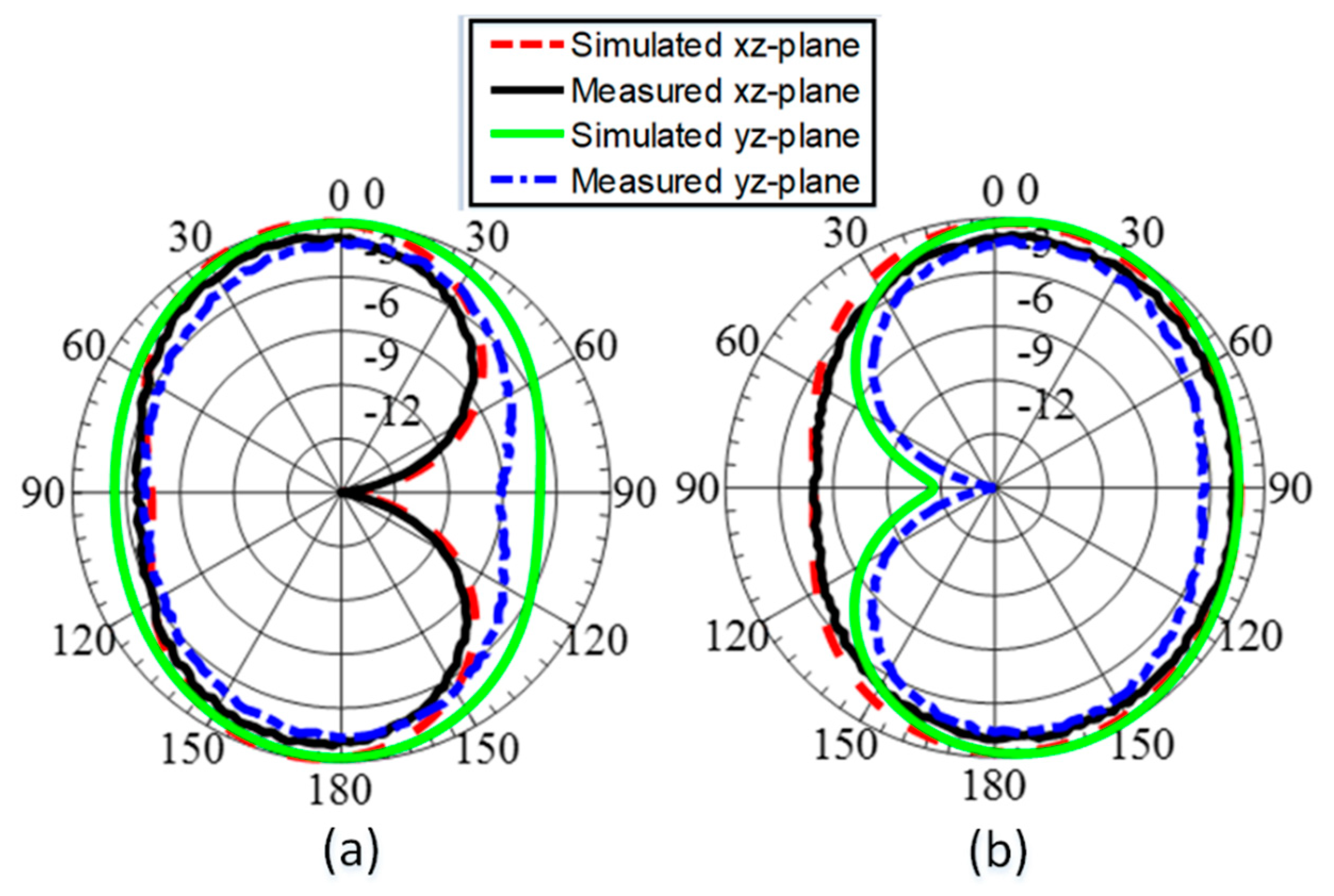
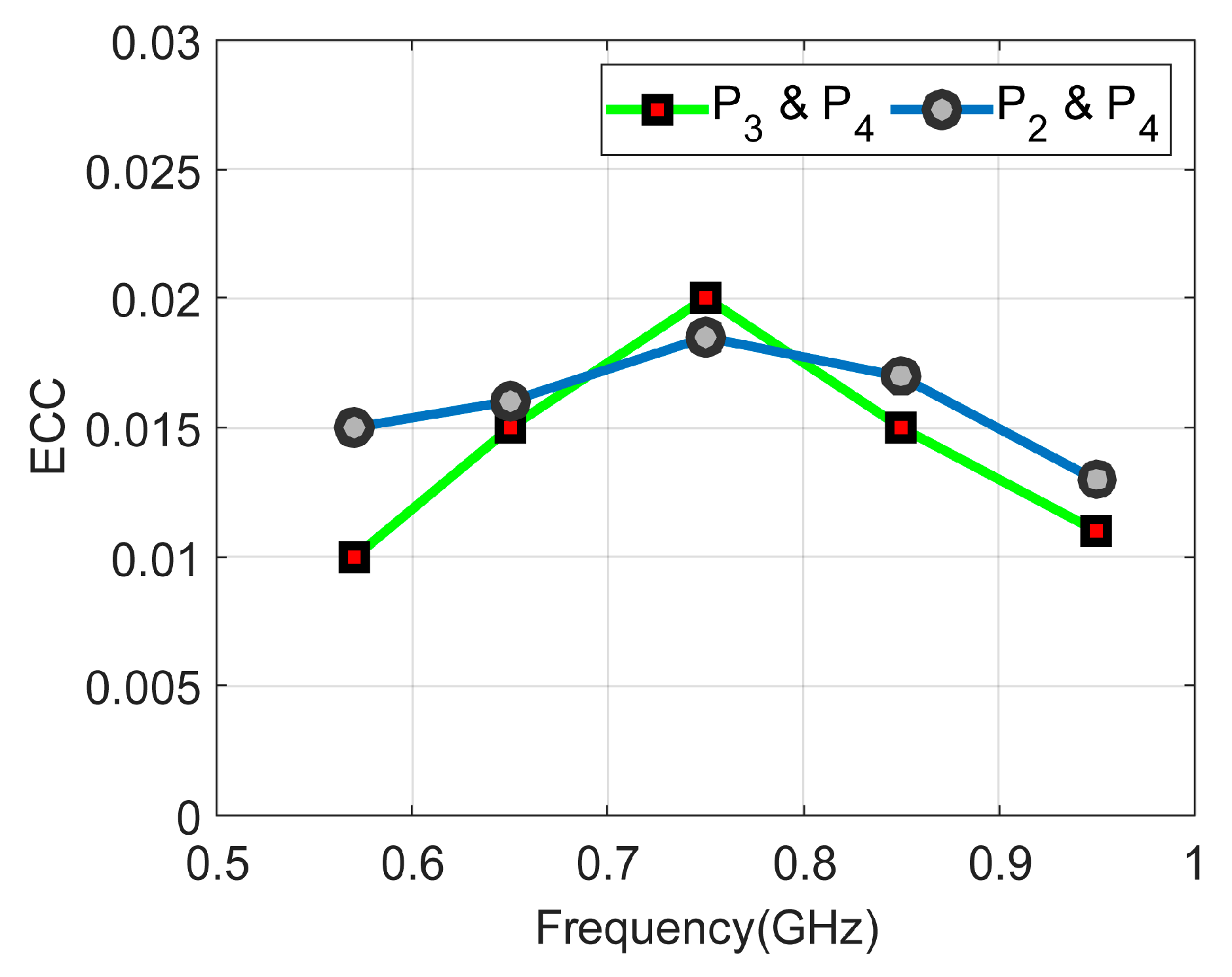
| Ref. | Reconfigurability | Low Profile | Support UHF | Pattern Diversity | Polarization | Remarks | ||
|---|---|---|---|---|---|---|---|---|
| [3] | 1.575 | No | No | No | No | CP | Helix | |
| [8] | 0.4 | No | Yes | Yes | No | Dual CP | Slot antenna | |
| [35] | 0.45 | No | No | Yes | Yes | LP | Folded slot antenna | |
| [38] | 0.9/5.8 | No | No | No | No | CP | Microstrip antenna with shaped ground + Fabry Perot | |
| [40] | 2.5 | No | Yes | No | No | CP | 2 Substrate + 2 foam layers | |
| [44] | 6 | Yes | No | No | Yes | LP | 3D structure | |
| [47] | 1.575/2.2 | No | Yes | No | No | CP | Stacked patch antenna of three layers | |
| [46] | 3.2/9.3 | No | Yes | No | No | Dual LP | Shared aperture antenna | |
| [48] | 1.69/2.45 | No | Yes | No | No | CP | Conical shape spiral antenna | |
| [49] | NA (1.5 U) | 0.48 | No | Yes | Yes | No | LP | Slot antenna on solar panel |
| [50] | 2.4 | Manual | Yes | No | No | LP | Patch/monopole antenna | |
| Proposed | 0.55 | Yes | Yes | Yes | Yes | Dual CP | Sensing antenna + two communication antennas |
Disclaimer/Publisher’s Note: The statements, opinions and data contained in all publications are solely those of the individual author(s) and contributor(s) and not of MDPI and/or the editor(s). MDPI and/or the editor(s) disclaim responsibility for any injury to people or property resulting from any ideas, methods, instructions or products referred to in the content. |
© 2023 by the authors. Licensee MDPI, Basel, Switzerland. This article is an open access article distributed under the terms and conditions of the Creative Commons Attribution (CC BY) license (https://creativecommons.org/licenses/by/4.0/).
Share and Cite
Aljaloud, K.; Sultan, K.; Ikram, M.; Alqahtani, A.H.; Abbasi, Q.H.; Hussain, R. Low-Profile Antenna System for Cognitive Radio in IoST CubeSat Applications. Sensors 2023, 23, 4782. https://doi.org/10.3390/s23104782
Aljaloud K, Sultan K, Ikram M, Alqahtani AH, Abbasi QH, Hussain R. Low-Profile Antenna System for Cognitive Radio in IoST CubeSat Applications. Sensors. 2023; 23(10):4782. https://doi.org/10.3390/s23104782
Chicago/Turabian StyleAljaloud, Khaled, Kamel Sultan, Muhammad Ikram, Ali H. Alqahtani, Qammar Hussain Abbasi, and Rifaqat Hussain. 2023. "Low-Profile Antenna System for Cognitive Radio in IoST CubeSat Applications" Sensors 23, no. 10: 4782. https://doi.org/10.3390/s23104782








